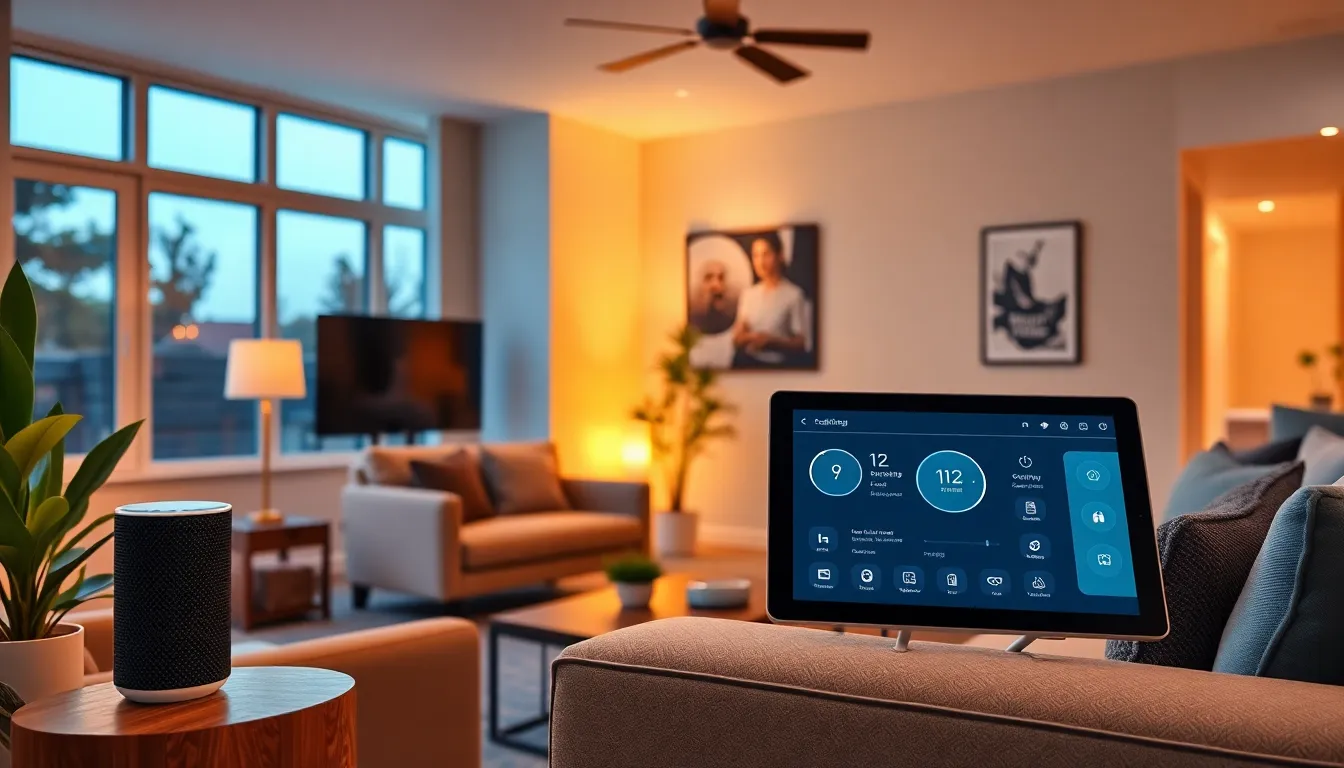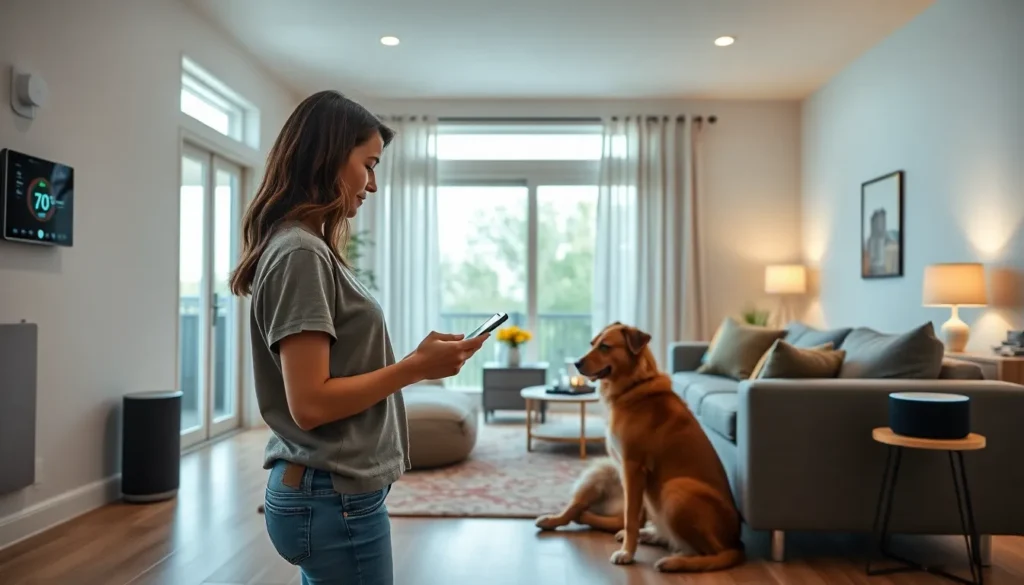Table of Contents
ToggleImagine a world where your coffee brews itself while you’re still snoozing, and your lights know when to dim for movie night without you lifting a finger. Welcome to the realm of Internet of Things (IoT) home automation, where everyday tasks transform into seamless experiences. This isn’t just sci-fi magic; it’s the future of living smartly, and it’s knocking at your front door.
Overview of Internet of Things Home Automation
Internet of Things home automation integrates smart devices into daily living environments. Smart thermostats, security cameras, and lighting systems enable remote control and automation of household functions. Such technology enhances convenience and efficiency, allowing seamless interaction among devices.
Users benefit from real-time monitoring and management of their homes. Energy consumption gets optimized through smart sensors that adjust settings based on occupancy. This results in long-term cost savings, adding to the appeal of IoT home automation systems.
Multiple platforms exist for device compatibility. Popular IoT ecosystems, such as Google Home, Amazon Alexa, and Apple HomeKit, allow various devices to connect and communicate. This interoperability streamlines user experience, making it simpler to command devices through voice or app controls.
Installation processes for IoT devices tend to be straightforward. Most products come with user-friendly instructions to facilitate setup. Some devices even connect to existing Wi-Fi networks, minimizing the need for specialized equipment.
Home security receives significant enhancements through IoT. Smart doorbells, locks, and cameras provide homeowners with remote monitoring capabilities and alert notifications. Such features promote safety and peace of mind, making IoT solutions increasingly attractive.
Trends indicate a growing adoption of IoT home automation technologies. Research from experts, such as Statista, suggests that the global smart home market could reach $174 billion by 2025. This growth reflects consumers’ increasing inclination toward connected living spaces, further driving innovation in home automation solutions.
Benefits of Internet of Things Home Automation

IoT home automation provides multiple advantages, enhancing daily living in various ways.
Enhanced Convenience
Smart devices streamline tasks, making life easier. Users can control everything from lighting to security systems remotely. Automation allows for pre-setting routines, such as having coffee brewing upon waking up. Voice commands simplify interactions, so no need for manual adjustments. Integrated technology also enables synchronized operation among devices, creating seamless experiences.
Increased Energy Efficiency
Devices connected to a smart home network optimize energy use. Automated scheduling reduces energy waste by adjusting heating or cooling preferences based on occupancy. Users receive notifications about energy consumption patterns, guiding them to make informed choices. Smart plugs allow for remote control of devices that draw power unnecessarily when not in use. Together, these features contribute to lower utility bills and a more eco-friendly lifestyle.
Improved Security
Enhanced security is a pivotal benefit of IoT home automation. Smart doorbells and cameras provide real-time monitoring, allowing homeowners to check on their properties from anywhere. Alerts notify users of unusual activity, enabling timely responses. Smart locks add convenience by allowing secure access without keys. Home automation maximizes safety, promoting peace of mind for residents and their families.
Components of Internet of Things Home Automation
Understanding the essential components of IoT home automation reveals the technology’s core functionalities. Key elements include smart devices and connectivity solutions.
Smart Devices
Smart devices serve as the backbone of IoT home automation systems. These gadgets range from smart thermostats to intelligent lighting systems, all designed for efficiency and convenience. Sensors integrated into these devices collect data and respond to user commands. Examples include smart speakers that facilitate voice commands and smart locks that enhance home security. Compatibility across different platforms like Amazon Alexa and Google Home plays a significant role in user satisfaction, allowing seamless control of multiple devices from one application. Users appreciate how these devices integrate into their daily routines, simplifying tasks and promoting a connected home environment.
Connectivity Solutions
Connectivity solutions establish communication between smart devices and user interfaces. Wi-Fi, Bluetooth, and Zigbee orchestrate this interaction, enabling devices to function effectively. Wi-Fi offers widespread accessibility, connecting devices across various distances within the home. Bluetooth often provides localized connectivity for devices in close proximity. Zigbee, designed for low-power devices, favors communication in smart home setups by managing multiple devices while conserving energy. Robust security protocols ensure that connections remain secure. Users recognize the importance of reliable connectivity in maintaining the functionality and responsiveness of their automated home systems.
Popular Applications in Home Automation
Various applications exemplify the functionality of IoT home automation, enhancing convenience and security for users. Notable areas include smart lighting, smart thermostats, and home security systems.
Smart Lighting
Smart lighting systems enable users to control brightness and color through mobile apps or voice commands. By utilizing schedules, devices can adjust lighting based on user presence or preferences. Energy savings emerge from motion sensors automatically turning lights off when no one is in a room. Popular brands such as Philips Hue and LIFX offer compatibility with platforms like Amazon Alexa and Google Home, allowing seamless integration. Homes benefit from the ability to create ambiance tailored to specific activities, such as relaxing or entertaining.
Smart Thermostats
Smart thermostats learn user habits to optimize heating and cooling in homes. They can analyze temperature patterns and adjust accordingly for maximum energy efficiency. With mobile access, homeowners can modify settings remotely, ensuring comfort upon arrival. Noteworthy options include the Nest Learning Thermostat and Ecobee SmartThermostat, featuring compatibility with various IoT systems. Reports illustrate potential energy savings of up to 23% on heating and cooling bills annually, demonstrating the financial benefits of adopting smarter climate control solutions.
Home Security Systems
Home security systems have transformed into sophisticated solutions offering real-time monitoring features. Smart cameras, doorbells, and locks provide users with alerts and access control from their smartphones. Integration with home automation systems enables users to configure routines that enhance security, such as automated lighting or simulated occupancy when away. Notable brands include Ring and Arlo, which feature standout technology like motion detection and two-way audio. Effective security measures can significantly increase homeowner confidence by protecting against intrusions and emergencies.
Challenges in Implementing Internet of Things Home Automation
Implementing Internet of Things home automation presents several challenges. These hurdles can significantly impact user experience and system performance.
Interoperability Issues
Interoperability remains a significant challenge due to diverse protocols. Many smart devices utilize different communication standards such as Wi-Fi, Bluetooth, or Zigbee. This variety can cause difficulties when integrating devices from multiple manufacturers. Some devices may not communicate effectively with others, leading to fragmented systems. Users often need to rely on proprietary hubs or platforms to ensure compatibility. This reliance complicates the user experience and can limit the overall functionality of smart homes.
Security Concerns
Security concerns are paramount in IoT home automation. Many devices collect and transmit sensitive data, making them attractive targets for cybercriminals. These vulnerabilities can lead to unauthorized access or data breaches, threatening homeowner privacy. Moreover, not all manufacturers implement robust security protocols, increasing risks. Effective security measures include regular firmware updates and strong, unique passwords for each device. Homeowners must stay informed about potential vulnerabilities to mitigate risks associated with their automated systems.
The rise of IoT home automation is reshaping how people interact with their living spaces. By seamlessly integrating technology into daily routines, it offers unmatched convenience and efficiency. Homeowners are empowered to optimize energy usage and enhance security with just a few taps or voice commands.
As the smart home market continues to grow, innovations will likely address current challenges, ensuring a more cohesive and secure experience. The future of home automation holds endless possibilities, making connected living not just a trend but a lifestyle choice. Embracing these advancements will undeniably lead to a smarter and more efficient way of living.




